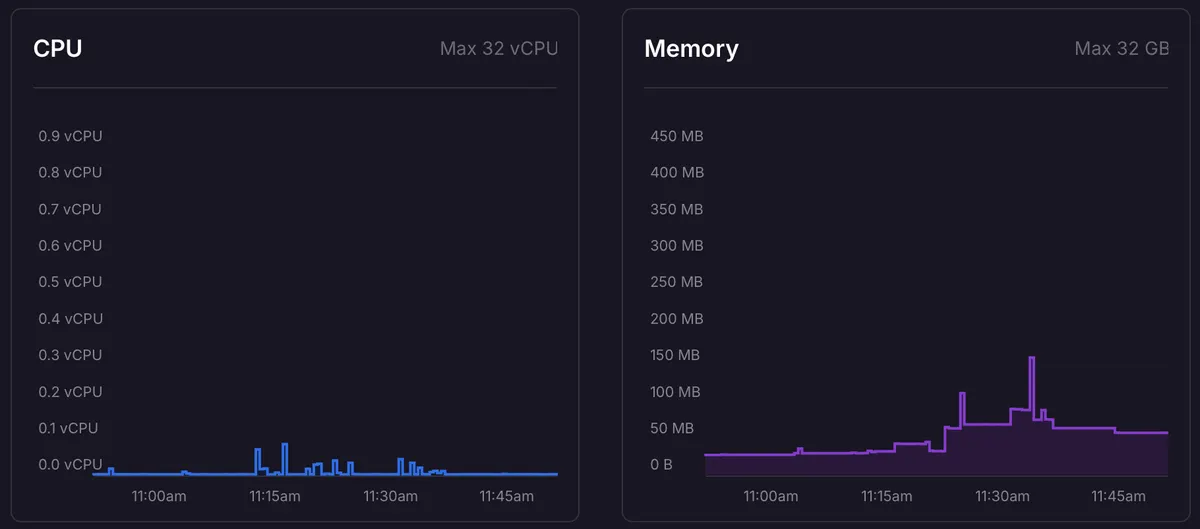scroll to the bottom to the see the implemented workflow, using imgproxy
Promising!
Ya it sounds not needed
We can try that. I am just afraid it’s going to be too slow

imgproxy seems to have a pretty small memory and CPU footprint
I think they compute demand based on use of cpus and memory dynamically. So I’m not sure yet if the api will use up it all
You also have the option of spinning up and down the service based on when it gets pinged , if you want to use it like a ‘server less’ service. (In service project settings )
From my understanding would it always run so it would have the maximum cost, just like the API service

Additional railway services are charged based on use , so it prob won’t cost much


after
Oh wow didn’t know webp could animate !
- additional railway cost through hosting one more service
I envisioned the system originally as the card displays a small filesize image but if you click into the card and click the image preview in there then it’ll send you to the url for the original upload
Coolness
I should’ve mentioned this earlier but a requirement is that the user can still fetch the original image. Is this possible w the proxy?
converts/compresses image and caches it for later
get original image
- only for images, although i think this is the 99% case so vids and audio are prob much less of a big deal. Although there are some niches like musicians where auto processing wav to mp3 is a hard requirement
- Should configure a CDN to cache images and make it more performant
- downside is that we have to host one more service (imgproxy)
+ Only requires small client-side changes
+ does not require to change how images are uploaded and stored on S3
+ Don’t have to worry about lib issues with Sharp etc.
+ may handle huge parallel loads of resizing tasks more efficiently
+ secured against ppl using images as an attack vector
+ separates the problem of optimizaton/compression/conversion of images from rest of the app
+ Easier to maintain
+ Can quickly try different compression & size settings because we request images & runtime
+ does not require server-side changes
+ does not introduce breaking changes if the solution does not work out
Image Proxy
S3
Transparent
how does imgproxy handle transparent gifs? and animated gifs?
after
before

before
Just tested it. For animated gifs it creates a smaller webp version 1,3 MB -> 126 KB
+ Don’t have to worry about lib issues with Sharp etc.
+ secured against ppl using images as an attack vector
+ may handle huge parallel loads of resizing tasks more efficiently
+ the same pipeline can be reused for other types of files
- might be slower because can only process one image at a time (but the client is also not dependent on fast img processing. it can take as long as it takes)
+ saves an http roundtrip
+ DRY we already have code for uploading to s3
- might end up being a lot of work bc of lib issues
+ easier to test, debug
requests image
responds with processed image
Kinopio Client
Kinopio Client
uploads image
- only for images, although i think this is the 99% case so vids and audio are prob much less of a big deal. Although there are some niches like musicians where auto processing wav to mp3 is a hard requirement
- if the server ever gets hosted on cdns, more work/expense to configure imgproxy to also be accessible via cdn
- downside is potentially increased maintainance/debugging/deployment burden
add url to db queue
kinopio-server updates the card record and websockets the small url to space
kinopio-server processes the file and uploads it to s3
after each user upload
imgproxy will process and upload the file to s3 , then send the processed url to kinopio-server
after each user upload,
for converting images
for converting audio and video
Original File
queue processing of original file URL
store processed file
Other (PDF, ZIP etc.)
do nothing
Convert to MP3
Audio
If file type
Convert to WebP or JPEG
Image
Video
convert to MP4
Pulls original file from S3 and creates optimized versions like described above in ‘Media Pipeline’
update client with new URL
Queueing via BullMQ which is backed by Redis
Redis
API Server
notify server of success
Worker
Client
uploads file
uploads original file to S3
S3
urlOriginalFile
urlFile
or if the file is a heic/tiff/wav or some other format that can’t be viewed in browsers
we only need to do img conversions in the case that the file is too large (by some threshold, like file size > 300 kb)
User uploads file to Kinopio
is there a reason to not always just use webp for images?
url to use in card name sent back to client (compressed version, or original if no compression needed)
Kinopio stores original file
Converted and compressed file





















